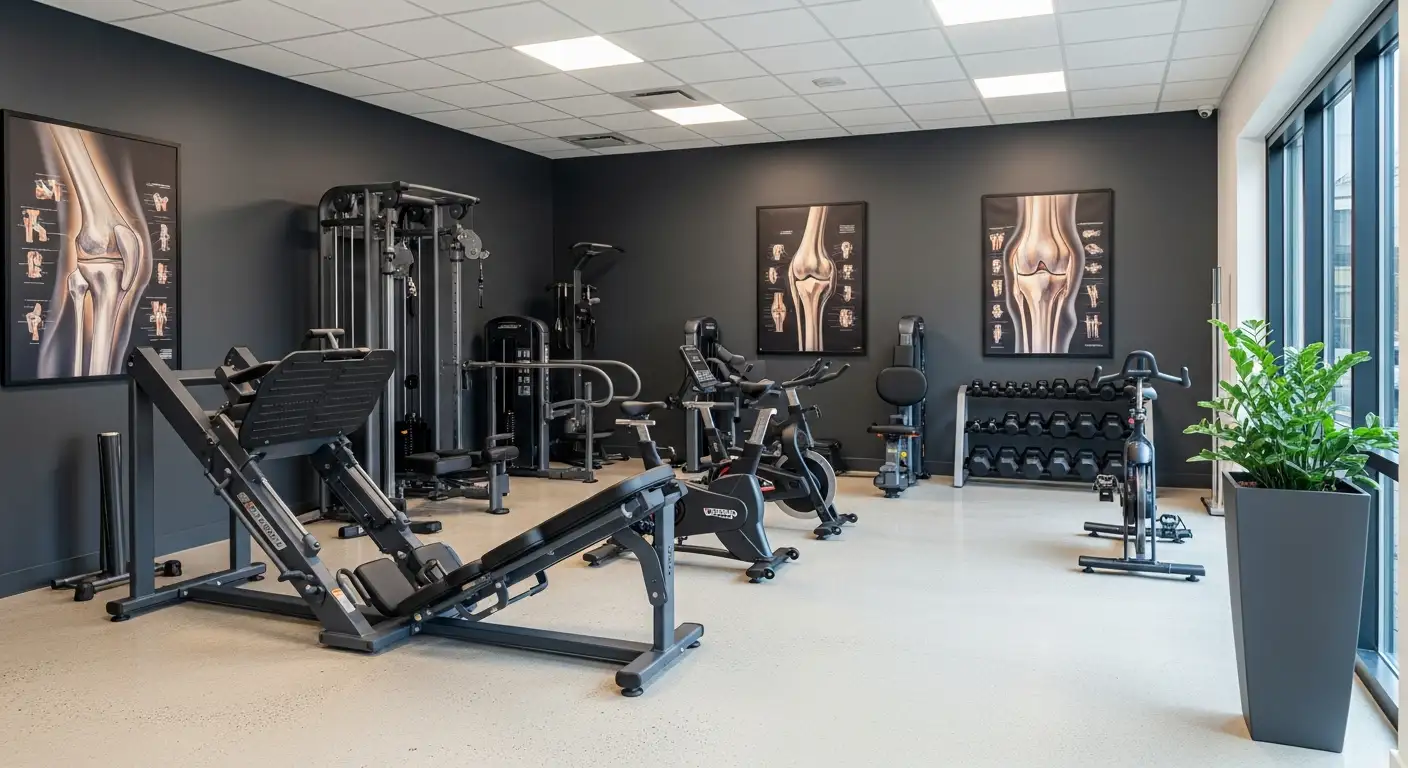Understanding Knee Pain
Knee pain can be a debilitating condition that significantly impacts an individual's quality of life. Understanding the common causes of knee pain and recognizing symptoms that require medical attention form the first steps towards effective management and treatment.
Common Causes of Knee Pain
Knee pain can be caused by several factors, including muscular imbalances, improper form during physical activities, and repetitive daily activities such as walking or stepping on and off curbs [1].

It's also crucial to achieve a good balance of strength and flexibility in muscles surrounding the knee joint, including quadriceps, hamstrings, iliotibial bands, gastrocnemius, and adductors. Weak or tight muscles can contribute to knee pain [2].
Specifically, strengthening the quadriceps, which play a vital role in supporting the knees, is important. Tight or weak quadriceps can contribute to pain in the knee area. In addition to quadriceps, having strong hips and core muscles are equally important for supporting a strong and healthy knee [2].
Symptoms Requiring Medical Attention
While engaging in knee pain exercises and stretches, it's crucial to identify and monitor any painful movements. Low-impact movements that do not cause pain are generally safe for individuals with knee pain. Conversely, sudden or twisting movements required in sports like soccer, skiing, and tennis, might be too strenuous on painful joints and should be avoided if they cannot be modified.
If an activity causes pain that lasts for days to weeks, and does not improve with modifications or rest, it is advisable to discontinue the exercise and find a different activity. Attempting to exercise through increasing pain can exacerbate the discomfort and potentially worsen the underlying issue causing the pain [2]. In such scenarios, it is important to seek medical attention to prevent further damage and to initiate appropriate treatment.
Understanding the root cause of knee pain and being aware of symptoms that may require medical intervention are critical steps in managing knee pain and improving knee health.
Exercises for Knee Pain Relief
Combating knee pain effectively often involves a combination of targeted exercises and stretches. These can help to strengthen the muscles around the knee, improve flexibility, and reduce tension on the knee joints. This section will cover some recommended exercises, including quadriceps strengthening exercises, hamstring stretching exercises, and low-impact aerobic activities.
Quadriceps Strengthening Exercises
The quadriceps are a group of muscles at the front of the thigh that play a crucial role in knee stability. Strengthening these muscles can help alleviate knee pain and improve overall knee function.
Some recommended quadriceps exercises include bodyweight squats, step-ups, and leg lifts. Bodyweight squats can help strengthen the muscles around the knee when performed with proper form, which includes keeping the feet shoulder-width apart and engaging the core [3]. Similarly, step-ups can improve knee strength and stability, provided the knee is kept aligned with the foot during the exercise to prevent twisting or strain.
Leg lifts are another beneficial exercise for strengthening the quadriceps. Straight leg raises, in particular, can help improve knee strength and stability [3].
It's noteworthy that some patients may encounter difficulty recalling the quadriceps stretching exercise, although they may remember the quadriceps isometric exercise better.
Hamstring Stretching Exercises
Hamstring stretches can improve flexibility and reduce stress on the knees. Simple stretches, like the towel hamstring stretch, can be effective in alleviating knee pain.
The towel hamstring stretch involves lying on your back with one leg bent and the other straight. Loop a towel around the foot of the straight leg and gently pull the towel towards you while keeping the leg straight. This should stretch the back of your leg, relieving tension in the hamstring muscles Healthline.
Low-Impact Aerobic Activities
In addition to targeted strengthening exercises and stretches, low-impact aerobic activities can also contribute to knee pain relief. These activities can help you maintain a healthy weight, which is beneficial for knee health, as extra weight can put additional strain on the knees.
Cycling is one such activity that can help improve knee strength and stability. It's easier on the knees than running or walking and can increase leg muscle strength without much strain on the knee joints.
Remember, it's important to consult with a healthcare professional before starting any new exercise regimen, especially if you're experiencing knee pain. They can help you determine which exercises are safe and beneficial for your specific condition. With the right exercises and stretches, you can work towards managing your knee pain more effectively.
The Role of Flexibility in Knee Health
Flexibility plays a significant role in knee health and is a crucial component of any regimen aimed to alleviate knee pain. It can help address muscular imbalances involved in knee pain by improving strength and flexibility, enabling better muscle utilization and reducing the risk of overextension and injury.
Importance of Muscle Balance
Achieving a good balance of strength and flexibility in the muscles surrounding the knee joint is crucial. This includes the quadriceps, hamstrings, iliotibial bands, gastrocnemius, and adductors. Weak or tight muscles can lead to knee pain. Strengthening the quadriceps, which play a vital role in supporting the knees, is particularly important as tight or weak quadriceps can contribute to pain in the knee area. Additionally, having strong hips and core muscles are equally important for supporting a strong and healthy knee.
General Flexibility Exercises
When performing knee pain exercises and stretches, focus should be on low-impact movements that do not cause pain. These are generally safe for individuals with knee pain. Conversely, sudden or twisting movements required in sports like soccer, skiing, and tennis, might be too strenuous on painful joints and should be avoided if they cannot be modified [2].
Remember, if an activity causes pain that lasts for days to weeks, and does not improve with modifications or rest, it is advisable to discontinue the exercise and find a different activity. Attempting to exercise through increasing pain can exacerbate the discomfort and potentially worsen the underlying issue causing the pain.
Precautions for Exercising with Knee Pain
While exercises and stretches can significantly aid in managing knee pain, it's crucial to approach them with caution. Certain movements could exacerbate the pain or potentially cause further damage. Therefore, understanding which exercises to perform and how to adjust one's regimen accordingly is essential.
Identifying Painful Movements
Recognizing the actions that cause discomfort or intensify knee pain is the first step in ensuring a safe and productive exercise routine. High-impact activities like running and jumping can exacerbate knee pain and cause further damage to the joints. It's important to avoid such activities and instead focus on low-impact exercises that are easier on the knees.
Implementing low-impact aerobic exercises like swimming, walking, and cycling can assist in reducing knee pain while promoting cardiovascular health.
It's crucial to consult a healthcare professional or physical therapist before starting any new exercise program to ensure that the exercises are appropriate and safe for one's condition.
Adjusting Exercise Regimens
Once you have identified the movements causing discomfort, the next step is adjusting your exercise regimen. Incorporating a mix of exercises and stretches that target different muscle groups and movement patterns can help enhance overall knee health and function, promoting better mobility and reducing the risk of knee pain and complications.
Strengthening exercises focusing on the quadriceps, hamstrings, calves, and hip muscles can help stabilize the knee joint and alleviate pain.
Regular physical activity and exercises tailored to knee pain can help improve strength, flexibility, and mobility in the knees, reducing pain and enhancing overall quality of life for individuals with knee issues.
However, as with any exercise regimen, it's important to start slowly and gradually increase the intensity to avoid overworking the knee joint. Always remember to warm up before starting an exercise session and cool down afterwards.
By taking these precautions into consideration, your knee pain exercises and stretches will not only be safer but also more effective in managing your knee pain.
Tips for Effective Knee Pain Management
While knee pain exercises and stretches can play a significant role in managing knee discomfort, other factors also contribute to a comprehensive knee pain management strategy. Two essential aspects are weight management and consultation with healthcare professionals.
Importance of Weight Management
A critical component of managing knee pain is maintaining a healthy weight. Excessive body weight can put additional stress on the knee joints, exacerbating knee pain and potentially accelerating joint deterioration. Consistent physical activity, combined with a balanced diet, can assist in weight management, thereby reducing stress on the knee joints. According to NHS Inform, maintaining a healthy weight is crucial for managing knee pain and preventing additional strain on the knee joints.
In addition to assisting in weight management, regular physical activity can help improve strength, flexibility, and mobility in the knees, reducing pain and enhancing the overall quality of life for individuals with knee issues. A well-rounded exercise routine that includes a balance of strength training, flexibility exercises, and cardiovascular activities can contribute to managing knee pain effectively.
Consulting Healthcare Professionals
Before embarking on any new exercise program, it is crucial to consult a healthcare professional or physical therapist. These experts can assess your condition and guide you on the appropriate and safe exercises for your condition. An expert's guidance ensures that you engage in beneficial exercises that won't further harm your knees [6].
Furthermore, healthcare professionals can provide advice on which activities to avoid. High-impact activities like running and jumping may exacerbate knee pain and cause further damage to the joints. Therefore, it's vital to understand which activities are safe and beneficial for your specific knee condition to ensure effective management of knee pain.
In conclusion, knee pain management is multifaceted, involving not just knee pain exercises and stretches, but also weight management and professional medical advice. By considering all these aspects, individuals can effectively manage knee pain and improve their quality of life.
References
[1]: https://www.hss.edu/article_stretches-exercises-knee-pain.asp
[2]: https://www.hss.edu/article_exercise-for-sore-knees.asp
[3]: https://www.healthline.com/health/exercises-for-knee-pain
[4]: https://www.ncbi.nlm.nih.gov/pmc/articles/PMC7075517/
[5]: https://centerforspineandortho.com/news/exercising-with-knee-pain-dos-and-donts/
[6]: https://www.medicalnewstoday.com/articles/325804
[7]: https://www.nhsinform.scot/illnesses-and-conditions/muscle-bone-and-joints/exercises/exercises-for-knee-problems/





